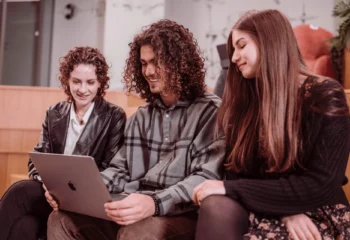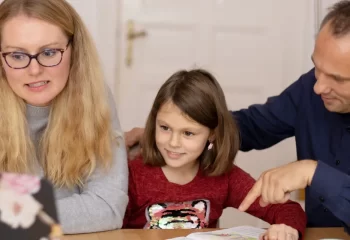Lockdown is an evergoing process in some countries, while in some, it is an on-off thing. This has taken a toll on students, and it is pretty hard for them to have a smooth learning journey. The growth and the importance of online learning increased the need for schools to develop this learning model and make it possible. Moreover, the usage of it increased the need to study its effects on students.
The entire education system from primary to higher level suffered significant transformations during isolation during the COVID-19 peak.
However, while seeing this option was not something we looked for or had any idea of, the truth is that it appeals to a broader population of students with different academic needs. Thus, the need to “provide quality education to all students, regardless of location and time” (Chaney, 2010. 0. 21) existed before.
What does online during lockdown mean for the school?
Each time a new way of communication and learning is implemented, many steps are made and should be taken into account so that students do not feel the difference. The on-off thing of online education is more than frustrating for many students. However, it seems that this is how things are done, and at this point, where COVID-19 is present, we must mingle between it. So doing the right thing and not the easiest thing is the answer.
Distance learning is the learning experience where students and teachers are separated by space and/or time. The community of students has especially been having this type of experiential learning for some time now, either full time or from time to time. While this type of ongoing school education system was not necessarily a must, it was asked for in these pandemic times we live in.
Nowadays, this non – formal education type has become an innovative teaching method. “From classroom-based forms of training to pedagogical scaling, from personal to virtual and from seminars to webinars.” (Danchikov, E. A., 2020, The Potential of Online Learning in Modern Conditions and Its Use at Different Levels of Education, Linguistic and Culture Review, 5(S1), 578 – 586.)
While in the beginning, schools were not ready for this periodical shift, nowadays, it seems that most of them shifted towards online learning as an alternative every time the need asks for and even for those students that prefer it.
Are the online courses light or hard to understand?
This is where the role of schools comes in and where they must work on. More than the course itself that must be well–structured, have clear instructions, be uploaded on a good learning platform – that should be functional as far as other learning activities students may have, teachers are the core.
It is, of course, hard for everyone involved, not just for students, to make this shift. But as a teacher and as an experienced adult, the expectations are that you can help the child or the student become familiarized and embrace this concept. Thus, well–trained teachers who know the perks of online education, know what their course intends to convey, understand the technology well, and help students if they have any hard time with it are essential.
Any online learning technology puts a high demand on teachers. Making sure schools help them with their course content creation, with their computer knowledge, provide them with online communication training tips for better clarity of expression while online teaching, and offer them the methods they need to connect with their students, is essential.
Having teachers prepared is one step further into making the online educational system work better. Course creators can “capitalize on the benefits that the online environment can offer” and “to minimize the challenges specific to the environment” (Thomson, 2010, p.703)
Effects on students
Students have gotten used to distance, online or blended learning models for almost two years now. While mixing them or not keeping consistency is not the right path, students do not seem to have had negative school results. When students had to use the digital to continue their academic education, they had to do their best to understand and make the most of the course.
According to a study (Cavanaugh. c et al., 2004, The effects of Distance Education On K-12 Student Outcomes: A Meta-Analysis), the distance education program had the same effect as far as the study concerns on students. The grade level, the courses, the content, the role of the instructor, the length of the program did not seem to have significant positive or negati9ve effects. Thus, at least up between the compared period – 1999 – 2004, there was no significant difference between students who participated in online learning and those who followed traditional education.
Seufert et al., 2020, a more recent study, shows that secondary school and university students preferred online classes during COVID’19 high peaks combined with asynchronous methods that allow them to go back to the material every time they need to.
In today’s situation, the blended learning model or any distance learning model is necessary, not a choice like before. This is why the differences of perception and of studying results might differ.
The advancement of modern technology helps students in this period of crisis a lot! They do not feel much difference between what they learned in face-to-face classes and online courses. The beginning was more challenging as they had to adjust their concentration levels and focus more while not having someone permanently watching over their shoulders. But it is sure a great opportunity for them, especially those in higher grades, to prepare for student life, career life, and life in general. Understanding the importance of focus and being totally into something helps students become fit for the future.
Most of the students are happy when faced with the freedom to make a choice – so allowing the student to choose when to learn, how much time to grant to the learning process, make his schedule, commit to a specific time is a great way to motivate children.
The advantages an online/ blended learning model brings
We can focus on what it does not bring, but that would not be an interesting point nor a useful one, as we are faced with integrating it from time to time or even making it a constant as this is what the pandemic situation brought.
Many students believe it is an excellent opportunity to “spend more time on concepts that I need help with and less on concepts that I can pick up quickly” (Kirtman, 2009, p.110)). More than ever, for students that do not usually have access to specific courses, online offers them the possibility to access them and show them more learning pathways.
And we say, it is better safe than just thinking of what if … what would it have been … and so many questions that do not make sense during a pandemic of this magnitude.
More than just protecting your child, an online/ blended learning model is the future, and we should quickly get accustomed to it. Having the traditional option as an option is good, but being prepared for a shift is far better.
Some of the advantages of the online/blended learning model are:
Flexibility
Safe
Constancy in the education process
Access to the material whenever children need
Helpful for developing focusing abilities.
Development of high level of technology skills
Immediate feedback
Multimodal content – through videos, podcasts, screencasts, video conferencing, presentation software
Tips for a good online/ blended model
There are some aspects the school should focus on when deciding to offer such a program.
Apart from the obvious, some valuable tips can help students focus and engage in the sessions:
Avoid long – classes.
Give a sufficient break between two consecutive classes.
Offer to work on an online course in joint groups.
Upload the videos of the course for each student to have access whenever they need a refresh.
Help create 3D virtual laboratories that will help the students with the practical online classes.
Interact as much as possible with the students – quizzes, tasks.
Maintain a social presence – communicate publicly and privately and create an environment that promotes an online sense of community. (Garrison & Vaughan, 2008)
Constant feedback.
Conclusion
There are many arguments to consider when concluding the online/ blended model of learning and traditional learning. They are not the same, but their intentions are the same.
This is what we should all keep in mind. No one is trying to take over the traditional model and replace it. Still, everyone is trying to offer a choice for continuous education in times of pandemic or other necessities.
“While distance learning may be most appropriate at colleges and universities […], there may be some educational advantages for institutions to integrate some of the best aspects of distance learning into traditional courses to build a “hybrid” learning environment.” (Hannay, M. & Newvine, T., 2006, Perception of Distance Learning: A Comparison of Online and Traditional learning)
The perception and the readiness of both teachers and students are what will drive any learning. Seeing the good part and remaining positive is what can be helpful in any situation. Embracing the change when needed or when wanting will surely be a plus for a better adaptation.
For this, we should work together to adapt the online models to be at least effective, if not just as effective as the traditional model. While each of them has its advantages and disadvantages, making sure they have one advantage in common is what should drive us. And this one advantage should be – offer children access to a high-class education where they can become fit for future.




